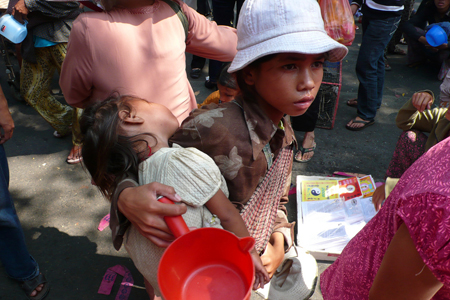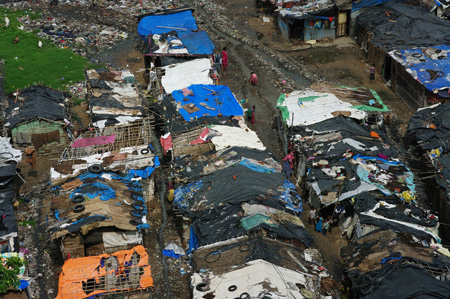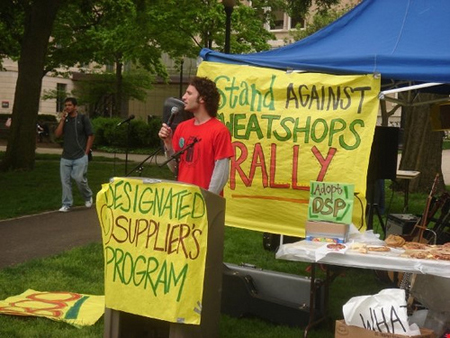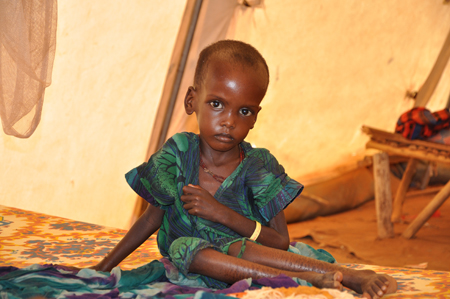Global Inequality
44 Global Wealth and Poverty
Learning Objectives
- Understand the differences between relative, absolute, and subjective poverty
- Describe the economic situation of some of the world’s most impoverished areas
- Explain the cyclical impact of the consequences of poverty

What does it mean to be poor? Does it mean being a single mother with two kids in New York City, waiting for the next paycheck in order to buy groceries? Does it mean living with almost no furniture in your apartment because your income doesn’t allow for extras like beds or chairs? Or does it mean having to live with the distended bellies of the chronically malnourished throughout the peripheral nations of Sub-Saharan Africa and South Asia? Poverty has a thousand faces and a thousand gradations; there is no single definition that pulls together every part of the spectrum. You might feel you are poor if you can’t afford cable television or buy your own car. Every time you see a fellow student with a new laptop and smartphone you might feel that you, with your ten-year-old desktop computer, are barely keeping up. However, someone else might look at the clothes you wear and the calories you consume and consider you rich.
Types of Poverty
Social scientists define global poverty in different ways and take into account the complexities and the issues of relativism described above. Relative poverty is a state of living where people can afford necessities but are unable to meet their society’s average standard of living. People often disparage “keeping up with the Joneses”—the idea that you must keep up with the neighbors’ standard of living to not feel deprived. But it is true that you might feel ”poor” if you are living without a car to drive to and from work, without any money for a safety net should a family member fall ill, and without any “extras” beyond just making ends meet.
Contrary to relative poverty, people who live in absolute poverty lack even the basic necessities, which typically include adequate food, clean water, safe housing, and access to healthcare. Absolute poverty is defined by the World Bank (2014a) as when someone lives on less than $1.25 a day. According to the most recent estimates, in 2011, about 17 percent of people in the developing world lived at or below $1.25 a day, a decrease of 26 percent compared to ten years ago, and an overall decrease of 35 percent compared to twenty years ago. A shocking number of people––88 million––live in absolute poverty, and close to 3 billion people live on less than $2.50 a day (Shah 2011). If you were forced to live on $2.50 a day, how would you do it? What would you deem worthy of spending money on, and what could you do without? How would you manage the necessities—and how would you make up the gap between what you need to live and what you can afford?

Subjective poverty describes poverty that is composed of many dimensions; it is subjectively present when your actual income does not meet your expectations and perceptions. With the concept of subjective poverty, the poor themselves have a greater say in recognizing when it is present. In short, subjective poverty has more to do with how a person or a family defines themselves. This means that a family subsisting on a few dollars a day in Nepal might think of themselves as doing well, within their perception of normal. However, a westerner traveling to Nepal might visit the same family and see extreme need.
What do the driver of an unlicensed hack cab in New York, a piecework seamstress working from her home in Mumbai, and a street tortilla vendor in Mexico City have in common? They are all members of the underground economy, a loosely defined unregulated market unhindered by taxes, government permits, or human protections. Official statistics before the worldwide recession posit that the underground economy accounted for over 50 percent of nonagricultural work in Latin America; the figure went as high as 80 percent in parts of Asia and Africa (Chen 2001). A recent article in the Wall Street Journal discusses the challenges, parameters, and surprising benefits of this informal marketplace. The wages earned in most underground economy jobs, especially in peripheral nations, are a pittance––a few rupees for a handmade bracelet at a market, or maybe 250 rupees ($5 U.S.) for a day’s worth of fruit and vegetable sales (Barta 2009). But these tiny sums mark the difference between survival and extinction for the world’s poor.
The underground economy has never been viewed very positively by global economists. After all, its members don’t pay taxes, don’t take out loans to grow their businesses, and rarely earn enough to put money back into the economy in the form of consumer spending. But according to the International Labor Organization (an agency of the United Nations), some 52 million people worldwide will lose their jobs due to the ongoing worldwide recession. And while those in core nations know that high unemployment rates and limited government safety nets can be frightening, their situation is nothing compared to the loss of a job for those barely eking out an existence. Once that job disappears, the chance of staying afloat is very slim.
Within the context of this recession, some see the underground economy as a key player in keeping people alive. Indeed, an economist at the World Bank credits jobs created by the informal economy as a primary reason why peripheral nations are not in worse shape during this recession. Women in particular benefit from the informal sector. The majority of economically active women in peripheral nations are engaged in the informal sector, which is somewhat buffered from the economic downturn. The flip side, of course, is that it is equally buffered from the possibility of economic growth.
Even in the United States, the informal economy exists, although not on the same scale as in peripheral and semi-peripheral nations. It might include under-the-table nannies, gardeners, and housecleaners, as well as unlicensed street vendors and taxi drivers. There are also those who run informal businesses, like daycares or salons, from their houses. Analysts estimate that this type of labor may make up 10 percent of the overall U.S. economy, a number that will likely grow as companies reduce head counts, leaving more workers to seek other options. In the end, the article suggests that, whether selling medicinal wines in Thailand or woven bracelets in India, the workers of the underground economy at least have what most people want most of all: a chance to stay afloat (Barta 2009).
Who Are the Impoverished?
Who are the impoverished? Who is living in absolute poverty? The truth that most of us would guess is that the richest countries are often those with the least people. Compare the United States, which possesses a relatively small slice of the population pie and owns by far the largest slice of the wealth pie, with India. These disparities have the expected consequence. The poorest people in the world are women and those in peripheral and semi-peripheral nations. For women, the rate of poverty is particularly worsened by the pressure on their time. In general, time is one of the few luxuries the very poor have, but study after study has shown that women in poverty, who are responsible for all family comforts as well as any earnings they can make, have less of it. The result is that while men and women may have the same rate of economic poverty, women are suffering more in terms of overall wellbeing (Buvinic 1997). It is harder for females to get credit to expand businesses, to take the time to learn a new skill, or to spend extra hours improving their craft so as to be able to earn at a higher rate.
Global Feminization of Poverty
In some ways, the phrase “global feminization of poverty” says it all: around the world, women are bearing a disproportionate percentage of the burden of poverty. This means more women live in poor conditions, receive inadequate healthcare, bear the brunt of malnutrition and inadequate drinking water, and so on. Throughout the 1990s, data indicated that while overall poverty rates were rising, especially in peripheral nations, the rates of impoverishment increased for women nearly 20 percent more than for men (Mogadham 2005).
Why is this happening? While myriad variables affect women’s poverty, research specializing in this issue identifies three causes (Mogadham 2005):
- The expansion in the number of female-headed households
- The persistence and consequences of intra-household inequalities and biases against women
- The implementation of neoliberal economic policies around the world
While women are living longer and healthier lives today compared to ten years ago, around the world many women are denied basic rights, particularly in the workplace. In peripheral nations, they accumulate fewer assets, farm less land, make less money, and face restricted civil rights and liberties. Women can stimulate the economic growth of peripheral nations, but they are often undereducated and lack access to credit needed to start small businesses.
In 2013, the United Nations assessed its progress toward achieving its Millennium Development Goals. Goal 3 was to promote gender equality and empower women, and there were encouraging advances in this area. While women’s employment outside the agricultural sector remains under 20 percent in Western Asia, Northern Africa, and Southern Asia, worldwide it increased from 35 percent to 40 percent over the twenty-year period ending in 2010 (United Nations 2013).
Africa
The majority of the poorest countries in the world are in Africa. That is not to say there is not diversity within the countries of that continent; countries like South Africa and Egypt have much lower rates of poverty than Angola and Ethiopia, for instance. Overall, African income levels have been dropping relative to the rest of the world, meaning that Africa as a whole is getting relatively poorer. Making the problem worse, 2014 saw an outbreak of the Ebola virus in western Africa, leading to a public health crisis and an economic downturn due to loss of workers and tourist dollars.
Why is Africa in such dire straits? Much of the continent’s poverty can be traced to the availability of land, especially arable land (land that can be farmed). Centuries of struggle over land ownership have meant that much useable land has been ruined or left unfarmed, while many countries with inadequate rainfall have never set up an infrastructure to irrigate. Many of Africa’s natural resources were long ago taken by colonial forces, leaving little agricultural and mineral wealth on the continent.
Further, African poverty is worsened by civil wars and inadequate governance that are the result of a continent re-imagined with artificial colonial borders and leaders. Consider the example of Rwanda. There, two ethnic groups cohabitated with their own system of hierarchy and management until Belgians took control of the country in 1915 and rigidly confined members of the population into two unequal ethnic groups. While, historically, members of the Tutsi group held positions of power, the involvement of Belgians led to the Hutu seizing power during a 1960s revolt. This ultimately led to a repressive government and genocide against Tutsis that left hundreds of thousands of Rwandans dead or living in diaspora (U.S. Department of State 2011c). The painful rebirth of a self-ruled Africa has meant many countries bear ongoing scars as they try to see their way towards the future (World Poverty 2012a).
Asia
While the majority of the world’s poorest countries are in Africa, the majority of the world’s poorest people are in Asia. As in Africa, Asia finds itself with disparity in the distribution of poverty, with Japan and South Korea holding much more wealth than India and Cambodia. In fact, most poverty is concentrated in South Asia. One of the most pressing causes of poverty in Asia is simply the pressure that the size of the population puts on its resources. In fact, many believe that China’s success in recent times has much to do with its draconian population control rules. According to the U.S. State department, China’s market-oriented reforms have contributed to its significant reduction of poverty and the speed at which it has experienced an increase in income levels (U.S. Department of State 2011b). However, every part of Asia is feeling the current global recession, from the poorest countries whose aid packages will be hit, to the more industrialized ones whose own industries are slowing down. These factors make the poverty on the ground unlikely to improve any time soon (World Poverty 2012b).
MENA
The Middle East and North Africa region (MENA) includes oil-rich countries in the Gulf, such as Iran, Iraq, and Kuwait, but also countries that are relatively resource-poor in relationship to their populations, such as Morocco and Yemen. These countries are predominately Islamic. For the last quarter-century, economic growth was slower in MENA than in other developing economies, and almost a quarter of the 300 million people who make up the population live on less than $2.00 a day (World Bank 2013).
The International Labour Organization tracks the way income inequality influences social unrest. The two regions with the highest risk of social unrest are Sub-Saharan Africa and the Middle East-North Africa region (International Labour Organization 2012). Increasing unemployment and high socioeconomic inequality in MENA were major factors in the Arab Spring, which—beginning in 2010—toppled dictatorships throughout the Middle East in favor of democratically elected government. Unemployment and income inequalities are still being blamed on immigrants, foreign nationals, and ethnic/religious minorities.

Most of us don’t pay too much attention to where our favorite products are made. And certainly when you’re shopping for a college sweatshirt or ball cap to wear to a school football game, you probably don’t turn over the label, check who produced the item, and then research whether or not the company has fair labor practices. But for the members of USAS––United Students Against Sweatshops––that’s exactly what they do. The organization, which was founded in 1997, has waged countless battles against both apparel makers and other multinational corporations that do not meet what USAS considers fair working conditions and wages (USAS 2009).
Sometimes their demonstrations take on a sensationalist tone, as in 2006 when twenty Penn State students protested while naked or nearly naked, in order to draw attention to the issue of sweatshop labor. The school is actually already a member of an independent monitoring organization called Worker Rights Consortium (WRC) that monitors working conditions and works to assist colleges and universities with maintaining compliance with their labor code. But the students were protesting in order to have the same code of conduct applied to the factories that provide materials for the goods, not just where the final product is assembled (Chronicle of Higher Education 2006).
The USAS organization has chapters on over 250 campuses in the United States and Canada and has waged countless campaigns against companies like Nike and Forever 21 apparel, Taco Bell restaurants, and Sodexo food service. In 2000, members of USAS helped to create the WRC. Schools that affiliate with WRC pay annual fees that help offset the organization’s costs. Over 180 schools are affiliated with the organization. Yet, USAS still sees signs of inequality everywhere. And its members feel that, as current and future workers, they are responsible for ensuring that workers of the world are treated fairly. For them, at least, the global inequality we see everywhere should not be ignored for a team spirit sweatshirt.
Consequences of Poverty

Not surprisingly, the consequences of poverty are often also causes. The poor often experience inadequate healthcare, limited education, and the inaccessibility of birth control. But those born into these conditions are incredibly challenged in their efforts to break out since these consequences of poverty are also causes of poverty, perpetuating a cycle of disadvantage.
According to sociologists Neckerman and Torche (2007) in their analysis of global inequality studies, the consequences of poverty are many. Neckerman and Torche have divided them into three areas. The first, termed “the sedimentation of global inequality,” relates to the fact that once poverty becomes entrenched in an area, it is typically very difficult to reverse. As mentioned above, poverty exists in a cycle where the consequences and causes are intertwined. The second consequence of poverty is its effect on physical and mental health. Poor people face physical health challenges, including malnutrition and high infant mortality rates. Mental health is also detrimentally affected by the emotional stresses of poverty, with relative deprivation carrying the most robust effect. Again, as with the ongoing inequality, the effects of poverty on mental and physical health become more entrenched as time goes on. Neckerman and Torche’s third consequence of poverty is the prevalence of crime. Cross-nationally, crime rates are higher, particularly for violent crime, in countries with higher levels of income inequality (Fajnzylber, Lederman, and Loayza 2002).
Slavery
While most of us are accustomed to thinking of slavery in terms of the antebellum South, modern day slavery goes hand-in-hand with global inequality. In short, slavery refers to any situation in which people are sold, treated as property, or forced to work for little or no pay. Just as in the pre-Civil War United States, these humans are at the mercy of their employers. Chattel slavery, the form of slavery once practiced in the American South, occurs when one person owns another as property. Child slavery, which may include child prostitution, is a form of chattel slavery. In debt bondage, or bonded labor, the poor pledge themselves as servants in exchange for the cost of basic necessities like transportation, room, and board. In this scenario, people are paid less than they are charged for room and board. When travel is required, they can arrive in debt for their travel expenses and be unable to work their way free, since their wages do not allow them to ever get ahead.
The global watchdog group Anti-Slavery International recognizes other forms of slavery: human trafficking (in which people are moved away from their communities and forced to work against their will), child domestic work and child labor, and certain forms of servile marriage, in which women are little more than chattel slaves (Anti-Slavery International 2012).
Summary
When looking at the world’s poor, we first have to define the difference between relative poverty, absolute poverty, and subjective poverty. While those in relative poverty might not have enough to live at their country’s standard of living, those in absolute poverty do not have, or barely have, basic necessities such as food. Subjective poverty has more to do with one’s perception of one’s situation. North America and Europe are home to fewer of the world’s poor than Africa, which has most poor countries, or Asia, which has the most people living in poverty. Poverty has numerous negative consequences, from increased crime rates to a detrimental impact on physical and mental health.
Section Quiz
Slavery in the pre-Civil War U.S. South most closely resembled
- chattel slavery
- debt bondage
- relative poverty
- peonage
A
Maya is a twelve-year-old girl living in Thailand. She is homeless, and often does not know where she will sleep or when she will eat. We might say that Maya lives in _________ poverty.
- subjective
- absolute
- relative
- global
B
Mike, a college student, rents a studio apartment. He cannot afford a television and lives on cheap groceries like dried beans and ramen noodles. Since he does not have a regular job, he does not own a car. Mike is living in:
- global poverty
- absolute poverty
- subjective poverty
- relative poverty
D
Faith has a full-time job and two children. She has enough money for the basics and can pay her rent each month, but she feels that, with her education and experience, her income should be enough for her family to live much better than they do. Faith is experiencing:
- global poverty
- subjective poverty
- absolute poverty
- relative poverty
B
In a U.S. town, a mining company owns all the stores and most of the houses. It sells goods to the workers at inflated prices, offers house rentals for twice what a mortgage would be, and makes sure to always pay the workers less than needed to cover food and rent. Once the workers are in debt, they have no choice but to continue working for the company, since their skills will not transfer to a new position. This situation most closely resembles:
- child slavery
- chattel slavery
- debt slavery
- servile marriage
C
Short Answer
Consider the concept of subjective poverty. Does it make sense that poverty is in the eye of the beholder? When you see a homeless person, is your reaction different if he or she is seemingly content versus begging? Why?
Think of people among your family, your friends, or your classmates who are relatively unequal in terms of wealth. What is their relationship like? What factors come into play?
Go to your campus bookstore or visit its web site. Find out who manufactures apparel and novelty items with your school’s insignias. In what countries are these produced? Conduct some research to determine how well your school adheres to the principles advocated by USAS.
Further Research
Students often think that the United States is immune to the atrocity of human trafficking. Check out the following link to learn more about trafficking in the United States: http://openstax.org/l/human_trafficking_in_US
For more information about the ongoing practices of slavery in the modern world click here: http://openstax.org/l/anti-slavery
References
Anti-Slavery International. 2012. “What Is Modern Slavery?” Retrieved January 1, 2012 (http://www.antislavery.org/english/slavery_today/what_is_modern_slavery.aspx).
Barta, Patrick. 2009. “The Rise of the Underground.” Wall Street Journal, March 14. Retrieved January 1, 2012 (ttp://online.wsj.com/article/SB123698646833925567.html).
Buvinić, M. 1997. “Women in Poverty: A New Global Underclass.” Foreign Policy, Fall (108):1–7.
Chen, Martha. 2001. “Women in the Informal Sector: A Global Picture, the Global Movement.” The SAIS Review 21:71–82
Chronicle of Higher Education. 2006. “Nearly Nude Penn State Students Protest Sweatshop Labor.” March 26. Retrieved January 4, 2012 (http://chronicle.com/article/Nearly-Nude-Penn-Staters/36772).
Fajnzylber, Pablo, Daniel Lederman, and Norman Loayza. 2002. “Inequality and Violent Crime.” Journal of Law and Economics 45:1–40.
International Labour Organization. 2012. “High Unemployment and Growing Inequality Fuel Social Unrest around the World.” Retrieved November 7, 2014 (http://www.ilo.org/global/about-the-ilo/newsroom/comment-analysis/WCMS_179430/lang–en/index.htm).
Neckerman, Kathryn, and Florencia Torche. 2007. “Inequality: Causes and Consequences.” Annual Review of Sociology 33:335–357.
Shah, Anup. 2011. “Poverty around the World.” Global Issues. Retrieved January 17, 2012 (http://www.globalissues.org/print/article/4).
U.S. Department of State. 2011a. “Background Note: Argentina.” Retrieved January 3, 2012 (http://www.state.gov/r/pa/ei/bgn/26516.htm).
U.S. Department of State. 2011b. “Background Note: China.” Retrieved January 3, 2012 (http://www.state.gov/r/pa/ei/bgn/18902.htm#econ).
U.S. Department of State. 2011c. “Background Note: Rwanda.” Retrieved January 3, 2012 (http://www.state.gov/r/pa/ei/bgn/2861.htm#econ).
USAS. 2009. “Mission, Vision and Organizing Philosophy.” August. Retrieved January 2, 2012 (http://usas.org).
World Bank. 2013. “Middle East and North Africa.” Retrieved November 7, 2014 (http://web.worldbank.org/WBSITE/EXTERNAL/COUNTRIES/MENAEXT/0,,menuPK:247619~pagePK:146748~piPK:146812~theSitePK:256299,00.html).
World Bank. 2014e. “Poverty Overview.” Retrieved November 7, 2014 (http://www.worldbank.org/en/topic/poverty/overview).
World Poverty. 2012a. “Poverty in Africa, Famine and Disease.” Retrieved January 2, 2012 (http://world-poverty.org/povertyinafrica.aspx).
World Poverty. 2012b “Poverty in Asia, Caste and Progress.” Retrieved January 2, 2012 (http://world-poverty.org/povertyinasia.aspx).
World Poverty. 2012c. “Poverty in Latin America, Foreign Aid Debt Burdens.” Retrieved January 2, 2012 (http://world-poverty.org/povertyinlatinamerica.aspx).
Glossary
- absolute poverty
- the state where one is barely able, or unable, to afford basic necessities
- chattel slavery
- a form of slavery in which one person owns another
- debt bondage
- the act of people pledging themselves as servants in exchange for money for passage, and are subsequently paid too little to regain their freedom
- relative poverty
- the state of poverty where one is unable to live the lifestyle of the average person in the country
- subjective poverty
- a state of poverty composed of many dimensions, subjectively present when one’s actual income does not meet one’s expectations
- underground economy
- an unregulated economy of labor and goods that operates outside of governance, regulatory systems, or human protections

